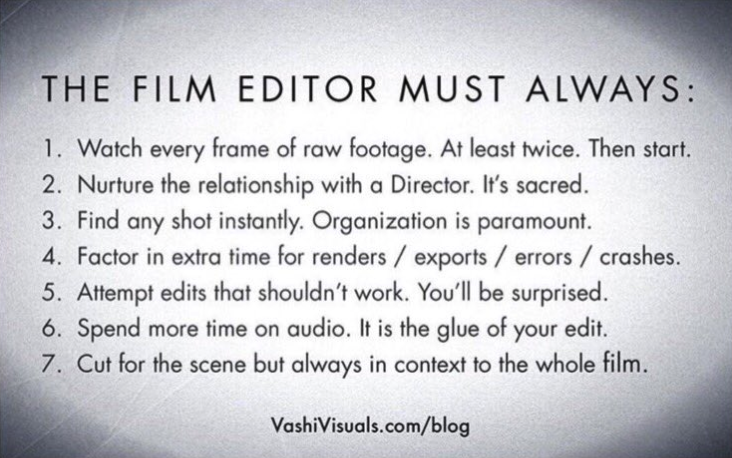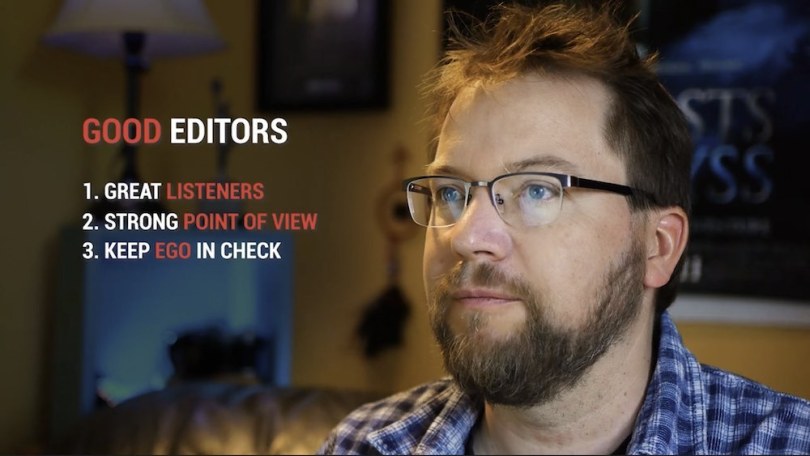
Three years ago, I launched a YouTube channel called This Guy Edits (TGE). Initially, I just wanted to show the process of cutting a specific feature film, “Flesh and Blood.” It was my third collaboration with director and Sundance filmmaker Mark Webber and I knew he would be game for the experiment.
Once that film was completed, I just kept going with the channel, because I suddenly had an audience, that was asking for more content. As the channel has evolved and grown from 0 to 250,000 subscribers it suddenly became a place to celebrate the bigger questions of creative editing and storytelling.
You might have heard the saying: 'Great editing is invisible.' While that may be true I aim to shed a little light onto the craft. And TGE is simply about celebrating the editor’s power of shaping a film through thousands of cuts. Editors are the "invisible performers in the editing room" as they shape an actor’s performance, enhances the dramatic impact of a scene, and connects an audience emotionally.
Increasingly, I’m inviting other editors to come onto the channel and present their work, techniques, and ideas, so that we can learn more from their work and appreciate the craft of editing together.
In my latest video, I had the opportunity to talk to Vashi Nedomansky, ACE, about his 7 laws of editing. He never called it that, but when I read a tweet of his, I thought it would make for a great video essay.
I always aim to not just talk about editing concepts, but actually apply them to the video itself. To be honest, I’m not very good with words on paper, but I love finding ways to visualize and emotionalize them with moving images, music and editing.
Here are Vashi’s insights explored in the video:
1. Watch every frame of raw footage. At least twice. Then start.
Ask any pro editor and they’ll tell you: Watching all the dailies is crucial. Start to finish. From the first to the last frame. The best reaction of an actor might come after the director has called “cut” because they relax and stop performing. Vashi suggests watching your footage twice: once from start to finish, letting the footage wash over you. Then again to take notes. To be honest, I watch my dailies once and I already make quick markers of how I feel. I keep my eyes on the screen, but have my hand on the keyboard using shortcuts for a three-tier system: It happened, it’s good, it’s gold. That’s all I need to remember how I felt about each moment.
Why does this matter? Ultimately, as the editor you are the one that is closest to the footage. No other person on the team will make more decisions about the detailed shaping of the story. While the director is the ultimate storyteller that carries the unified vision, it is the editor who makes a thousand impactful decisions that will never be questioned. So, you better make sure that you come from a place of knowledge.
2. Nurture your relationship with the director
The editor is the only other person who gets to see all the weaknesses and flaws of the film. The editor is also the one that needs to fix them. So, that relationship with the director is very special. It’s like a marriage that needs to endure all the challenges of rearing the film. If you have an ego or are short-tempered, no talent will keep you from getting fired. Be open minded, be nurturing, and most importantly, listen more than you speak. It’s the director’s voice that needs to be seen and heard in the film. But it also means that sometimes you need to stand up and protect the film, especially when the director is unsure and loses faith.

Sven’s tips to help you nurture better relationships with your collaborators.
3. Find any shot instantly. Organization is paramount.
I actually think this goes hand in hand with number one. As you are watching and taking notes, it’s very important to sort the footage in the right place. A good folder and coding system helps you remember how you felt and gives you instant access to your instincts. It also helps you stay in flow, especially when the director is sitting with you and you both are shaping the film. You don’t want media-management to get in the way of being creative.
4. Factor in extra time for renders, exports, errors, and crashes
Pro editors deliver on time all the time. To follow through on that part of your brand (which is simply a promise of an experience), you must have a plan in place for mishaps and always check your work before it leaves your hands. A flash frame, an offline piece of media, a glitch in the output can always happen, but should be fixed through a workflow system that makes time for quality control.
5. Attempt edits that shouldn’t work. You’ll be surprised.
Some of my best edits come from happy accidents. You never know how two shots will work together unless you throw them in a timeline and watch what they do. Our brains are wired to make connections where there might be none (intended). It’s good to have a plan, but oftentimes being bold and careless is just as effective.
6. Spend more time on audio. It’s the glue of the edit.
I bet you've heard this one before. But it is astounding to me how many cuts I watch with little care for audio with the excuse that this will be fixed later by the sound. A cut needs to screen like it could play in a theater right now and the audience wouldn’t be able to tell that it’s a rough cut. That’s the only way to judge whether a scene is working or not. Bad audio leads to bad notes from the director.
7. Cut for the scene but always in context to the whole film.
Scenes have an arc on their own, but they really ultimately need to work in context with what happens overall. So, cut each scene as good as it can be, but then play them as connected beats and see how they hold up. Do they need to be shorter or longer? Do they need a different focus? Sometimes a scene can be a great spectacle but do very little in advancing the story or our emotional engagement with the main character. The film might play better without them completely or with a different purpose. Sometimes you have to cut scenes, even as painful as it might be.
And, here’s a bonus tip not on Vashi’s list.
While you’re growing as an editor, it’s important to show your cuts to others for feedback. Whether you are editing a full length feature or a short 1 minute video for social media, your edits will either be confirmed by viewers or become better with feedback from your peers or mentors.
I recently started using Wipster for feedback with my YouTube channel’s Patreon community and Go-To-Editor Course. I’m able to leave feedback on my patron’s cuts to help them grow as editors on their own. But you can also use Wipster to send a quick edit, daily, or scene, to someone on your team if you need their insights or approval. You can sign up for a Wipster plan to see how it works with your editing workflow.
I hope you found these points useful and let me know which ones resonate with you most.
Wipster's Position on your Data and Content Rights
A lot has been made recently about Adobe's far-reaching Terms of Service, which grant them the right to access all their customers' content through...



